Staff Inquiry: Get in My Belly – Food Scenes Good Enough To Eat
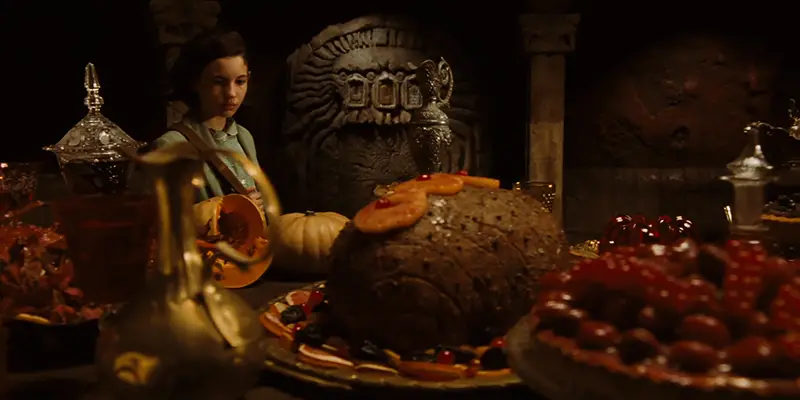
Arlin is an all-around film person in Oakland, CA. He…
One of the few common experiences not only among different cultures, but different species, is the act of eating. We all just have to do it, and we don’t have a say in it. Food unites high and low, left and right, young and all, through necessity and playful manipulation of our senses. But how does one communicate a sensation that is wholly of taste and smell through a medium of sight and sound?
When the question was put to the Film Inquiry staff, a torrent let loose of all the cinematic moments that had us salivating like Pavlovian hounds. These are our picks, but be forewarned that by the end of the article you might feel at least a wee bit peckish.
Julia Smith – Peter’s Friends (1992) – Reunion Dinner
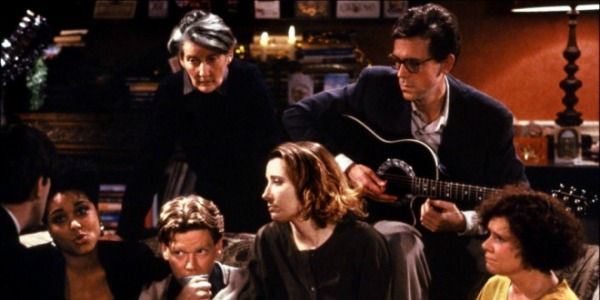
Dir. Kenneth Branagh
I first saw Peter’s Friends as a teenager, a few years after it was made, and to me it was all that was brilliant about British cinema. Written by Americans, there is something quintessentially British about its self-deprecating humour. The film stars a host of British talent who soon became legends, among them Stephen Fry, Hugh Laurie, Emma Thompson and Imelda Staunton.
The film centers around Peter (Fry), whose father has passed away. Inheriting a grand estate and seemingly unsure of what to do next, he invites his old university friends for a New Year’s holiday. But they have all now accumulated adult problems, which they drag along with them and unveil over the course of the narrative. From an adult’s point of view I can now see the film for what it is: a grand, healing catharsis, and it all begins with their reunion dinner.
The first dinner scene in Peter’s Friends is actually more of a montage, edited skilfully to the sound of The Pretenders’ “Don’t Get Me Wrong”. It’s all about the joy that comes when you’re reunited with people who understand you and who, after hours of relaxing over food and drink, you begin to miss for the first time in eons. Of course, someone says the wrong thing, the scene ends, and the film’s narrative kicks off. But then maybe that’s the way it should be – all joy must be tinged with sadness or how could we ever know that we were happy?
This scene, and the ensuing uncoiling of the characters resonates so much more with me now. I have learnt more about the actors and also about what has happened to them since the making of the film. Fry, Laurie and Thompson are actually all friends from university, with Laurie and Thompson being a couple for a while. Thompson’s mother, actress Phyllida Law, plays Peter’s housekeeper in the film, while Kenneth Branagh and Emma Thompson were together when this film was made, but have since divorced.
Importantly, of course, we have learnt about Fry and Tony Slattery’s difficulties with mental illness. But while they are all superb actors, the problems and emotions I saw onscreen as a young teenager have gained greater depths because of these realities. What is more, I’ve learned the importance of this scene; the importance of eating and drinking, and relaxing with friends who understand you. There’s nothing quite like it.
Dave Fontana – Chef (2014) – Grilled Cheese Scene
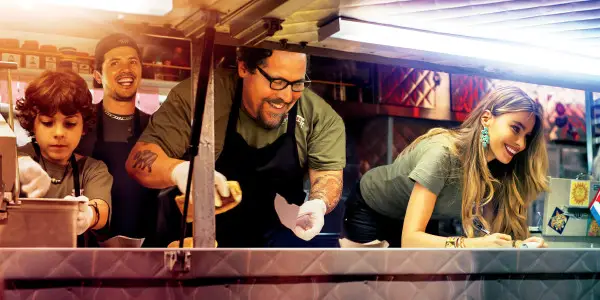
Dir. Jon Favreau
Chef is a movie almost entirely dedicated to the art of cooking. Jon Favreau, who also wrote and directed the film, stars as Carl Casper, a renowned chef who loses his job at a pristine California restaurant and later opens his own Cuban-style food truck. The best food scene of the film comes not from Casper’s gourmet cooking, though, but from the simple act of making a grilled cheese sandwich for his son.
With the delicate precision of a sculptor, Casper dribbles oil on a stove, layers the bread with carefully sliced assorted cheeses, flips the sizzling sandwich over, and then brushes on some butter. Filmed in a stark close-up, the crunchy, melty sandwich looks quite appetizing, and is notably under-appreciated by his son, who takes one bite and simply says: “it’s good.” Though the scene is relatively short, its deeper meaning is evident by the close of the film.
Carl Casper is a man with an obvious love for food; even if just making a quick snack for his son, the end result must be no less than perfection. Such a passion, though, can be overpowering, to the point that it interferes with even more important aspects of life, such as family (he even says as much in a later scene in the film). In the grilled cheese scene, for instance, Casper seemed much more invested in the act of cooking the sandwich than in engaging in a conversation with his son soon afterwards.
The real purpose of the events in Chef, then, are not to show the decline and rebirth of a man’s career in cooking, but instead in how he finally manages to balance his life around that passion. It is through the simple act of cooking a grilled cheese sandwich for his son that he finally starts to understand the importance of family.
https://youtu.be/5BTfctEmg5w
Alistair Ryder – Pan’s Labyrinth (2006) – The Pale Man
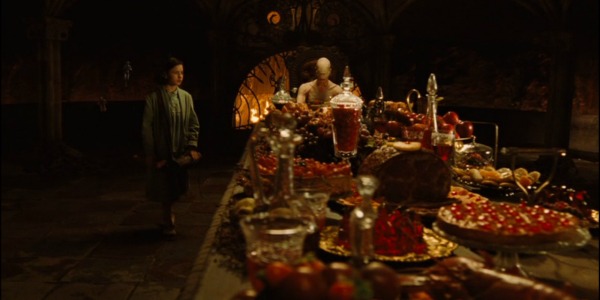
Dir. Guillermo del Toro
From a very early age, we are repeatedly told that eating fruit and vegetables is good for you; in Britain, the government recently increased the required amount of fruit and veg a day from five items to seven. In the harsh fantasia hidden beneath a crippled Civil War Spain in director Guillermo Del Toro’s masterful Pan’s Labyrinth, eating two grapes is all it takes to get your life threatened, not saved.
In one of the most tense and memorable sequences of 21st century cinema, Ofelia (Ivana Baquero) is sent to retrieve a dagger that is being guarded by the Pale Man (Doug Jones); a creepy creature with eyeballs for hands who has a track record of devouring children. The Pale Man famously only wakes up if any of the treats laid out on the table in front of him are eaten – and it is here that the anti-fruit subtext is made clear.
Instead of eating a turkey leg or a pastry, Ofelia launches straight to the grapes; instead of keeping her healthy, the fruit puts her life in danger, leading to a genuinely nail-biting chase sequence. This subtext is purely unintentional (I doubt Del Toro had any beef with the fruit industry), but it does add to the childlike innocence of this dark fairytale subversion. After all, children always devise ways to avoid eating their fruit and vegetables – and nothing is going to scare them off healthy eating more than a monster with eyes on its hands chasing any fruit-hungry child, in the hope of eating them for its dinner.
In a film designed for older audiences, it is amusing to see a child not just with a strong appetite for healthy eating, but facing punishment in the narrative because of it.
Tyler George – 4 Months, 3 Weeks, 2 Days (2007) – Dinner Scene
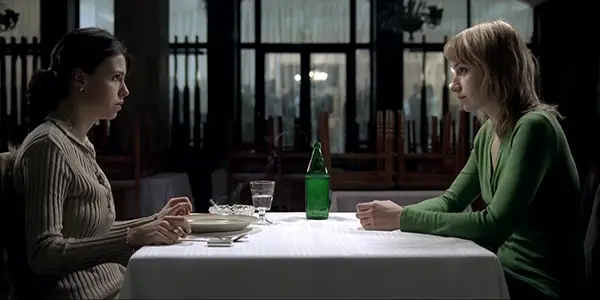
Dir. Cristian Mungiu
I can understand why 4 Months, 3 Weeks, 2 Days is not the first “food movie” that will come to most people’s minds; it is not a food movie and that much is sure. Cristian Mungiu’s movie depicts a woman who undergoes an illegal abortion under Romania’s oppressive dictatorship, which was on the verge of collapse in the late 1980s.
In a film loaded with virtuosic camera work, harrowing subject matter, and distressing realism, its most disruptive moment is a roughly seven-minute single-take, static frame medium close-up of Otilia (Anamaria Marinca) as she sits with her family to dinner. By using this long, single shot, Mungiu stimulates anxiety that mimics the scene being depicted. This scene interrupts the action of navigating the black market to procure the illegal service for her friend Gabita (Laura Vasiliu). As Otilia’s family eats, they are oblivious to the horrible reality happening off-screen.
Maybe it says more about me than anything else that I thought of this movie first when prompted. But this dinner scene is, for me, one of the most memorable and meaningful in all of cinema. The scene earns its weight from off-screen events in the same way that the rest of the film does: several discussions of bread lines and other aspects of the regime are never directly shown. In this sense the movie is very much a portrait of life under the brutal dictator Nicolae Ceaușescu.
The dinner scene depicts a woman forced to carry a secret even from her closest relatives. As viewers sit through the dinner, Mungiu makes material use of cinema’s temporal dimension to represent the terror of this otherwise mundane mealtime gathering.
Arlin Golden – Krush Groove (1985) – All You Can Eat
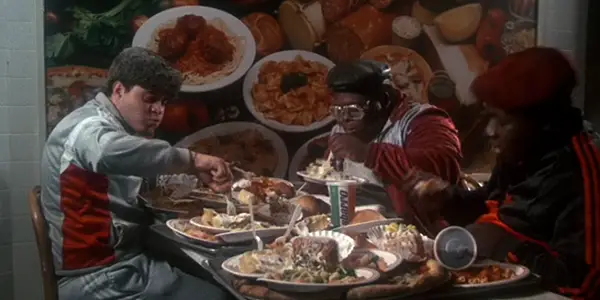
Dir. Michael Schultz
Perhaps more than any other musical act aside from Weird Al Yankovich, The Fat Boys predicated their entire persona on food. Their raps where about things like getting thrown in jail for stealing pizza or devouring rival MCs whole. So when they were brought on board to Russell Simmon‘s Def Jam showcase film Krush Groove, it must have been a foregone conclusion that there would have to be a scene where the Fat Boys eat copious amounts of food. Enter original rap superstar, co-star of the film and mentor to the Fat Boys, Kurtis Blow, to pen what would become one of the groups most enduring hits, and I think the film’s brightest scene (though “Don’t You Dog Me” might have something to say about that).
Emerging from the subway famished from a day causing mischief in their school hallways, Kool Rock-Ski, Prince Markie Dee, and Buff the Human Beatbox happen upon a Sbarro’s foolish enough to offer an all you can eat special in the path of the trio’s daily commute. After some comical ogling, the beat kicks in and we’re into the number for “All You Can Eat”, a song about little more than its title implies, and The Fat Boys off to the proverbial races.
The scene acts as more than just a pleasant and danceable musical interlude though; it also serves the purpose of an origin story for the group. In a bit of seriously lazy writing, they decide that they are so fat, they should call themselves The Fat Boys. And a legend is born. The song has found a permanent nook in my brain that releases it whenever I read the phrase “all you can eat” anywhere, and the scene enjoys a unique place as a document of the transitioning of hip-hop from insurgent to commodified. But mostly I just like the idea of being able to order via beatboxing and eating pasta murals off the wall.
https://www.youtube.com/watch?v=drGeLouMm6s
Jax Griffin – The Phantom of Liberty (1974) – Dinner Scene
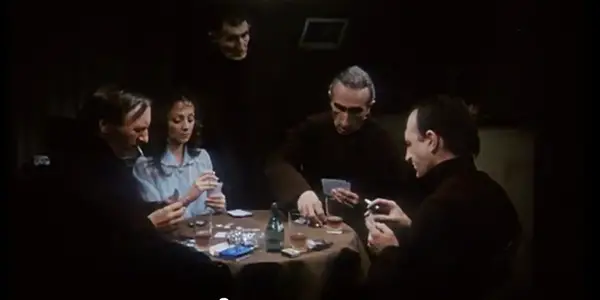
Dir. Luis Buñuel
Luis Buñuel’s bizarre satire The Phantom of Liberty takes a look at the lives of several characters, particularly those of the upper class persuasion, over the course of several short segments. However, one scene stands out in my memory like a fart at a funeral, and that is the bathroom-dinner scene. If you aren’t familiar, allow me to set the stage for you.
A group of people gather together to enjoy a meal. They sit down at a large dining table, around which are several toilets rather than chairs, and they all proceed to use the toilet together. At one point, a lady excuses herself with some embarrassment and goes off to a separate, private room, and eats a meal.
In fairness, this scene is oft discussed in connection to the film, so I’m not exactly breaking new territory here. But what Buñuel does is completely invert our ideas of what is appropriate for polite society. It’s a wonderfully absurd (to our minds) “what if” game where the filmmaker asks: “What if we were as embarrassed of eating as we were of using the toilet?” Both are functions of sustaining life. Trust me, if you can’t both ingest and excrete in some way, you WILL die. But we, as a society, have arbitrarily celebrated one function whilst shaming the other.
I love this movie and I love this scene, not because it’s particularly layered or even subtle, but because of the really quite reasonable supposition it placed in my head when I watched it. I’d never considered before that perhaps our rituals were a bit odd. I thought maybe they were a bit boring sometimes (you go to enough dinner parties and you’ll agree), but perfectly normal. Therein lies Buñuel’s real question – who decides what’s normal and acceptable? And why should we listen to them?
I mean you and I can sit here and sum this up all day, but don’t you just want to go into the kitchen right now and pretend everything you eat just harmlessly dissolves in your stomach like its nothing? Thanks for reading and bon apetit! ::chew chew chew slurrrppp chew chew:: Oh! You’re still here. You must want some closure then. I understand.
Like food, film is a medium that promotes unity; we congregate at restaurants side by side with total strangers as we do in a movie theater, and we leave with a shared experience despite not having spoken a word to one another. So it seems quite natural, then, that though they engage with different parts of our consciousness, film can deliver a good deal of the similar effects of a meal. Both are described as a feast, after all. Now seriously, bon apetit.
Which scenes make you want to go to the lobby and get yourself a treat?
Does content like this matter to you?
Become a Member and support film journalism. Unlock access to all of Film Inquiry`s great articles. Join a community of like-minded readers who are passionate about cinema - get access to our private members Network, give back to independent filmmakers, and more.
Arlin is an all-around film person in Oakland, CA. He received his BA in Film Studies in 2010, is a documentary distributor and filmmaker, and runs Drunken Film Fest Oakland. He rarely dreams, but the most frequent ones are the ones where it's finals and he hasn't been to class all semester. He hopes one day that the world recognizes the many values of the siesta system.












